CHC33015: Client Developmental Status and Mental Health Assessment
VerifiedAdded on 2023/04/21
|23
|8181
|279
Homework Assignment
AI Summary
This assignment comprehensively examines client developmental status within the context of mental health. It begins by outlining the six stages of human development, detailing the characteristics and challenges associated with each stage from pre-adulthood to old age. The assignment then presents a table analyzing various areas of development, including cognitive, social and emotional, moral, and psychosexual aspects across different age ranges, describing expected observations. It further explores the biopsychosocial framework, explaining how biological, psychological, and social forces interact to influence human development. The assignment delves into Erikson's stages of psychosocial development, detailing the crisis and virtues associated with each stage from infancy to old age. Additionally, the role of neuroscience in understanding brain development and its impact on human behavior is discussed. The lifespan perspective model, which views human development as multidirectional, multicultural, multidisciplinary, and multi-contextual, is also analyzed. The selective optimization with compensation model, particularly relevant for older adults, is presented, focusing on strategies for successful aging. Finally, the assignment addresses child abuse within the biopsychosocial framework, examining the biological, psychological, and social dimensions of this issue. This assignment provides a detailed overview of key concepts in developmental psychology and mental health assessment.

HEALTHCARE
MENTAL HEALTH
MENTAL HEALTH
Paraphrase This Document
Need a fresh take? Get an instant paraphrase of this document with our AI Paraphraser
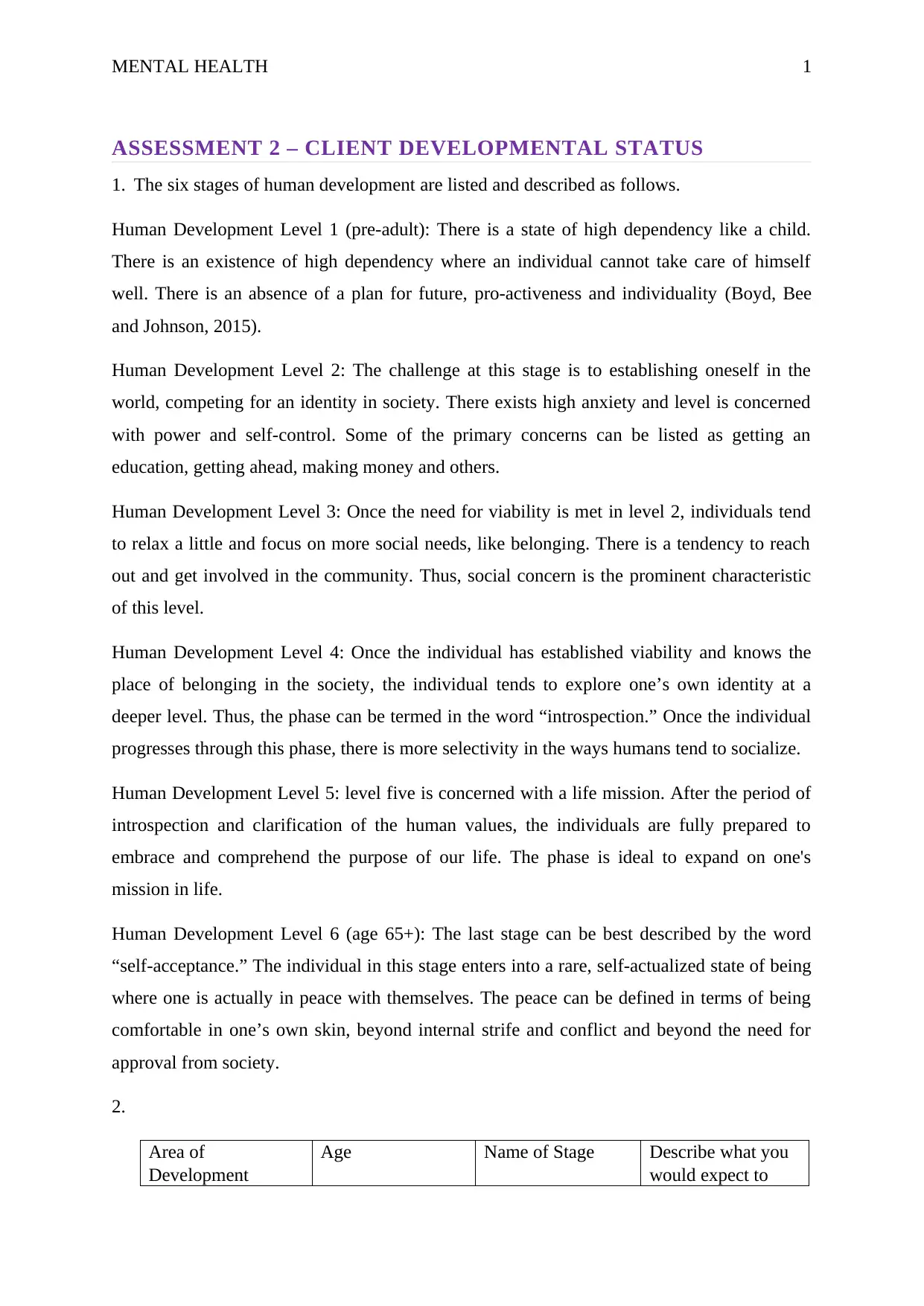
MENTAL HEALTH 1
ASSESSMENT 2 – CLIENT DEVELOPMENTAL STATUS
1. The six stages of human development are listed and described as follows.
Human Development Level 1 (pre-adult): There is a state of high dependency like a child.
There is an existence of high dependency where an individual cannot take care of himself
well. There is an absence of a plan for future, pro-activeness and individuality (Boyd, Bee
and Johnson, 2015).
Human Development Level 2: The challenge at this stage is to establishing oneself in the
world, competing for an identity in society. There exists high anxiety and level is concerned
with power and self-control. Some of the primary concerns can be listed as getting an
education, getting ahead, making money and others.
Human Development Level 3: Once the need for viability is met in level 2, individuals tend
to relax a little and focus on more social needs, like belonging. There is a tendency to reach
out and get involved in the community. Thus, social concern is the prominent characteristic
of this level.
Human Development Level 4: Once the individual has established viability and knows the
place of belonging in the society, the individual tends to explore one’s own identity at a
deeper level. Thus, the phase can be termed in the word “introspection.” Once the individual
progresses through this phase, there is more selectivity in the ways humans tend to socialize.
Human Development Level 5: level five is concerned with a life mission. After the period of
introspection and clarification of the human values, the individuals are fully prepared to
embrace and comprehend the purpose of our life. The phase is ideal to expand on one's
mission in life.
Human Development Level 6 (age 65+): The last stage can be best described by the word
“self-acceptance.” The individual in this stage enters into a rare, self-actualized state of being
where one is actually in peace with themselves. The peace can be defined in terms of being
comfortable in one’s own skin, beyond internal strife and conflict and beyond the need for
approval from society.
2.
Area of
Development
Age Name of Stage Describe what you
would expect to
ASSESSMENT 2 – CLIENT DEVELOPMENTAL STATUS
1. The six stages of human development are listed and described as follows.
Human Development Level 1 (pre-adult): There is a state of high dependency like a child.
There is an existence of high dependency where an individual cannot take care of himself
well. There is an absence of a plan for future, pro-activeness and individuality (Boyd, Bee
and Johnson, 2015).
Human Development Level 2: The challenge at this stage is to establishing oneself in the
world, competing for an identity in society. There exists high anxiety and level is concerned
with power and self-control. Some of the primary concerns can be listed as getting an
education, getting ahead, making money and others.
Human Development Level 3: Once the need for viability is met in level 2, individuals tend
to relax a little and focus on more social needs, like belonging. There is a tendency to reach
out and get involved in the community. Thus, social concern is the prominent characteristic
of this level.
Human Development Level 4: Once the individual has established viability and knows the
place of belonging in the society, the individual tends to explore one’s own identity at a
deeper level. Thus, the phase can be termed in the word “introspection.” Once the individual
progresses through this phase, there is more selectivity in the ways humans tend to socialize.
Human Development Level 5: level five is concerned with a life mission. After the period of
introspection and clarification of the human values, the individuals are fully prepared to
embrace and comprehend the purpose of our life. The phase is ideal to expand on one's
mission in life.
Human Development Level 6 (age 65+): The last stage can be best described by the word
“self-acceptance.” The individual in this stage enters into a rare, self-actualized state of being
where one is actually in peace with themselves. The peace can be defined in terms of being
comfortable in one’s own skin, beyond internal strife and conflict and beyond the need for
approval from society.
2.
Area of
Development
Age Name of Stage Describe what you
would expect to
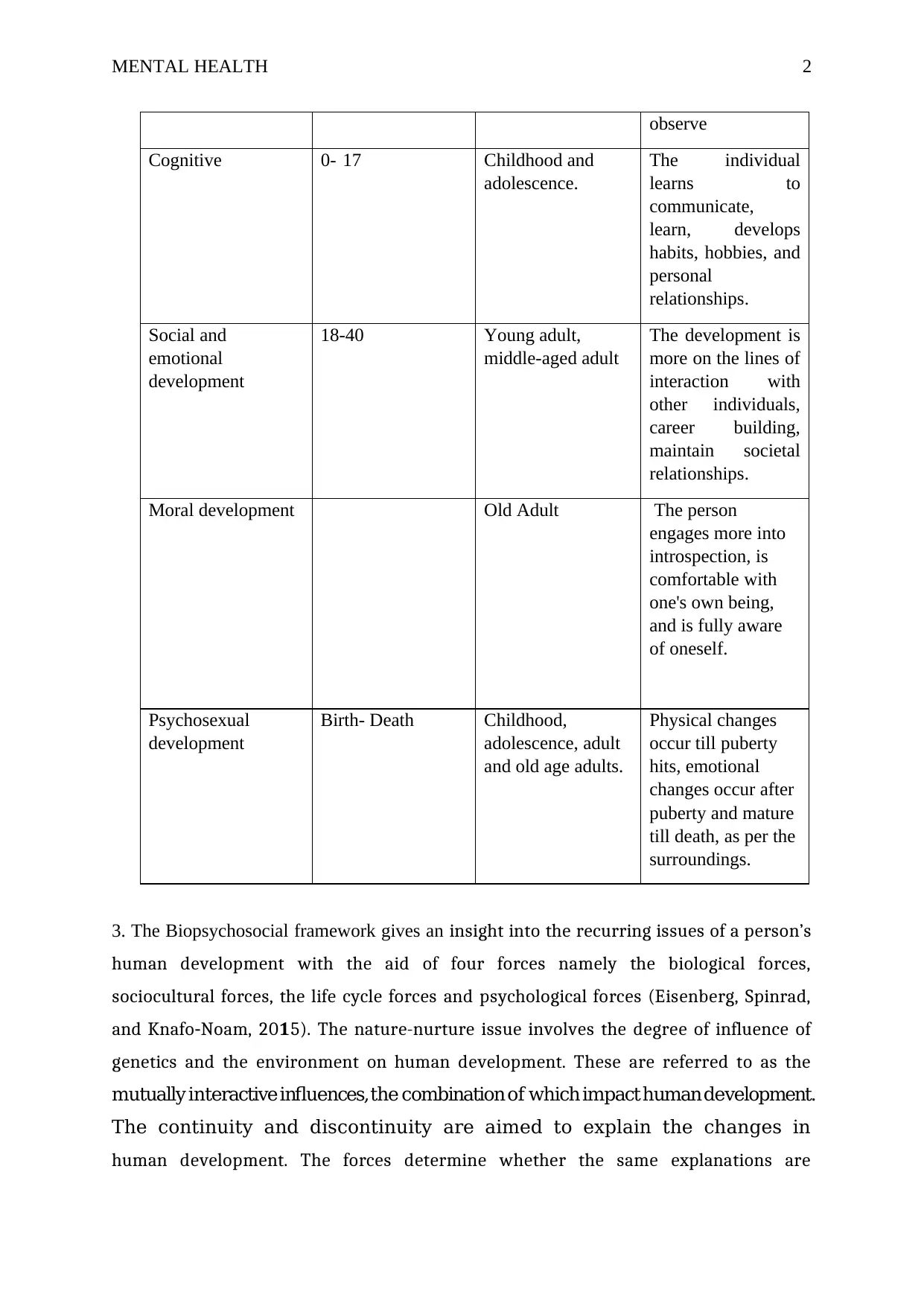
MENTAL HEALTH 2
observe
Cognitive 0- 17 Childhood and
adolescence.
The individual
learns to
communicate,
learn, develops
habits, hobbies, and
personal
relationships.
Social and
emotional
development
18-40 Young adult,
middle-aged adult
The development is
more on the lines of
interaction with
other individuals,
career building,
maintain societal
relationships.
Moral development Old Adult The person
engages more into
introspection, is
comfortable with
one's own being,
and is fully aware
of oneself.
Psychosexual
development
Birth- Death Childhood,
adolescence, adult
and old age adults.
Physical changes
occur till puberty
hits, emotional
changes occur after
puberty and mature
till death, as per the
surroundings.
3. The Biopsychosocial framework gives an insight into the recurring issues of a person’s
human development with the aid of four forces namely the biological forces,
sociocultural forces, the life cycle forces and psychological forces (Eisenberg, Spinrad,
1and Knafo Noam, 20 5). The nature-nurture issue involves the degree of influence of‐
genetics and the environment on human development. These are referred to as the
mutually interactive influences, the combination of which impact human development.
The continuity and discontinuity are aimed to explain the changes in
human development. The forces determine whether the same explanations are
observe
Cognitive 0- 17 Childhood and
adolescence.
The individual
learns to
communicate,
learn, develops
habits, hobbies, and
personal
relationships.
Social and
emotional
development
18-40 Young adult,
middle-aged adult
The development is
more on the lines of
interaction with
other individuals,
career building,
maintain societal
relationships.
Moral development Old Adult The person
engages more into
introspection, is
comfortable with
one's own being,
and is fully aware
of oneself.
Psychosexual
development
Birth- Death Childhood,
adolescence, adult
and old age adults.
Physical changes
occur till puberty
hits, emotional
changes occur after
puberty and mature
till death, as per the
surroundings.
3. The Biopsychosocial framework gives an insight into the recurring issues of a person’s
human development with the aid of four forces namely the biological forces,
sociocultural forces, the life cycle forces and psychological forces (Eisenberg, Spinrad,
1and Knafo Noam, 20 5). The nature-nurture issue involves the degree of influence of‐
genetics and the environment on human development. These are referred to as the
mutually interactive influences, the combination of which impact human development.
The continuity and discontinuity are aimed to explain the changes in
human development. The forces determine whether the same explanations are
⊘ This is a preview!⊘
Do you want full access?
Subscribe today to unlock all pages.

Trusted by 1+ million students worldwide
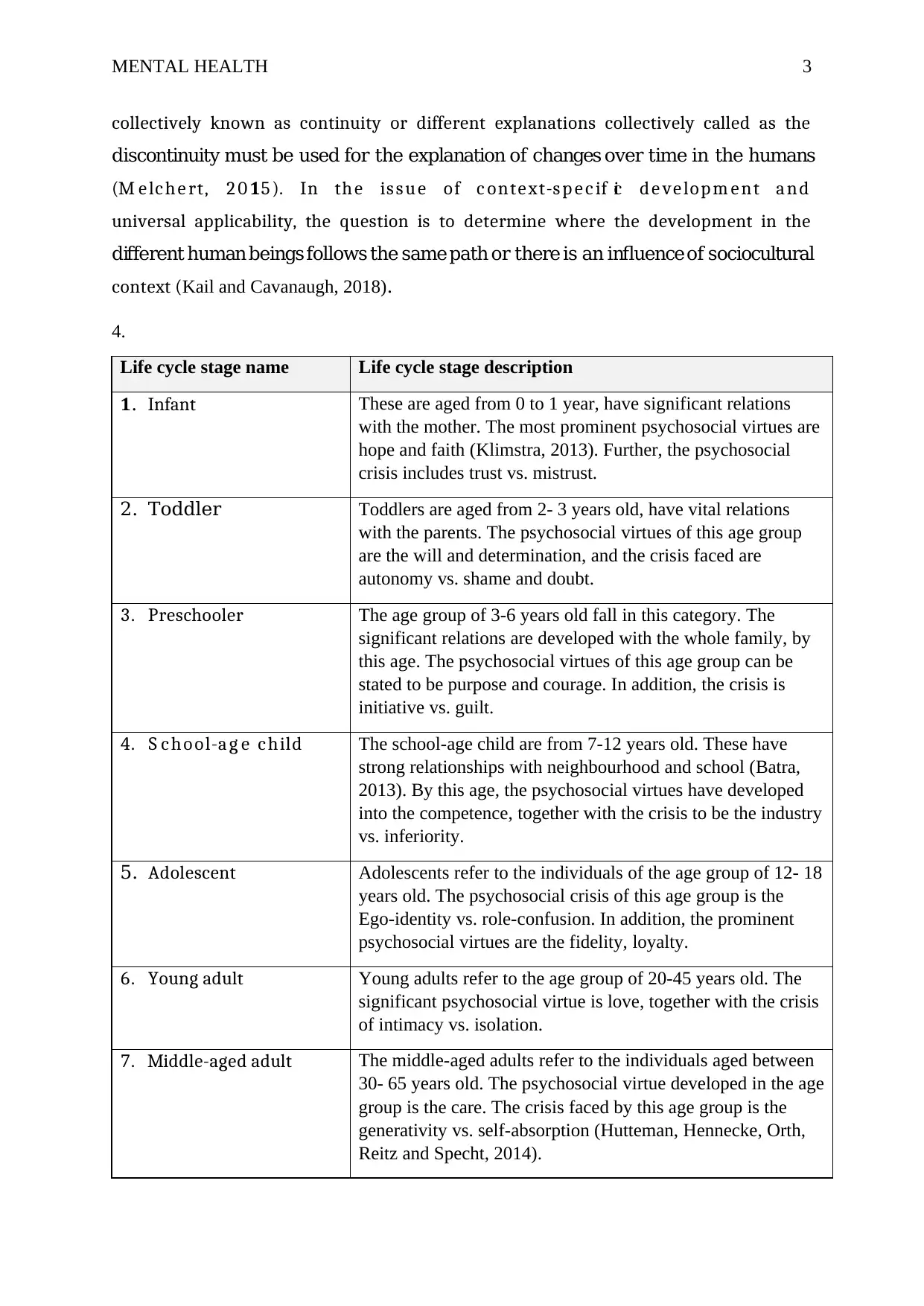
MENTAL HEALTH 3
collectively known as continuity or different explanations collectively called as the
discontinuity must be used for the explanation of changes over time in the humans
1(M e lc he rt, 20 5). In the issue of c onte xt-spe c if ic de ve lopm e nt a nd
universal applicability, the question is to determine where the development in the
different human beings follows the same path or there is an influence of sociocultural
context (Kail and Cavanaugh, 2018).
4.
Life cycle stage name Life cycle stage description
1. Infant These are aged from 0 to 1 year, have significant relations
with the mother. The most prominent psychosocial virtues are
hope and faith (Klimstra, 2013). Further, the psychosocial
crisis includes trust vs. mistrust.
2. Toddler Toddlers are aged from 2- 3 years old, have vital relations
with the parents. The psychosocial virtues of this age group
are the will and determination, and the crisis faced are
autonomy vs. shame and doubt.
3. Preschooler The age group of 3-6 years old fall in this category. The
significant relations are developed with the whole family, by
this age. The psychosocial virtues of this age group can be
stated to be purpose and courage. In addition, the crisis is
initiative vs. guilt.
4. S c hool-a g e c hild The school-age child are from 7-12 years old. These have
strong relationships with neighbourhood and school (Batra,
2013). By this age, the psychosocial virtues have developed
into the competence, together with the crisis to be the industry
vs. inferiority.
5. Adolescent Adolescents refer to the individuals of the age group of 12- 18
years old. The psychosocial crisis of this age group is the
Ego-identity vs. role-confusion. In addition, the prominent
psychosocial virtues are the fidelity, loyalty.
6. Young adult Young adults refer to the age group of 20-45 years old. The
significant psychosocial virtue is love, together with the crisis
of intimacy vs. isolation.
7. Middle-aged adult The middle-aged adults refer to the individuals aged between
30- 65 years old. The psychosocial virtue developed in the age
group is the care. The crisis faced by this age group is the
generativity vs. self-absorption (Hutteman, Hennecke, Orth,
Reitz and Specht, 2014).
collectively known as continuity or different explanations collectively called as the
discontinuity must be used for the explanation of changes over time in the humans
1(M e lc he rt, 20 5). In the issue of c onte xt-spe c if ic de ve lopm e nt a nd
universal applicability, the question is to determine where the development in the
different human beings follows the same path or there is an influence of sociocultural
context (Kail and Cavanaugh, 2018).
4.
Life cycle stage name Life cycle stage description
1. Infant These are aged from 0 to 1 year, have significant relations
with the mother. The most prominent psychosocial virtues are
hope and faith (Klimstra, 2013). Further, the psychosocial
crisis includes trust vs. mistrust.
2. Toddler Toddlers are aged from 2- 3 years old, have vital relations
with the parents. The psychosocial virtues of this age group
are the will and determination, and the crisis faced are
autonomy vs. shame and doubt.
3. Preschooler The age group of 3-6 years old fall in this category. The
significant relations are developed with the whole family, by
this age. The psychosocial virtues of this age group can be
stated to be purpose and courage. In addition, the crisis is
initiative vs. guilt.
4. S c hool-a g e c hild The school-age child are from 7-12 years old. These have
strong relationships with neighbourhood and school (Batra,
2013). By this age, the psychosocial virtues have developed
into the competence, together with the crisis to be the industry
vs. inferiority.
5. Adolescent Adolescents refer to the individuals of the age group of 12- 18
years old. The psychosocial crisis of this age group is the
Ego-identity vs. role-confusion. In addition, the prominent
psychosocial virtues are the fidelity, loyalty.
6. Young adult Young adults refer to the age group of 20-45 years old. The
significant psychosocial virtue is love, together with the crisis
of intimacy vs. isolation.
7. Middle-aged adult The middle-aged adults refer to the individuals aged between
30- 65 years old. The psychosocial virtue developed in the age
group is the care. The crisis faced by this age group is the
generativity vs. self-absorption (Hutteman, Hennecke, Orth,
Reitz and Specht, 2014).
Paraphrase This Document
Need a fresh take? Get an instant paraphrase of this document with our AI Paraphraser
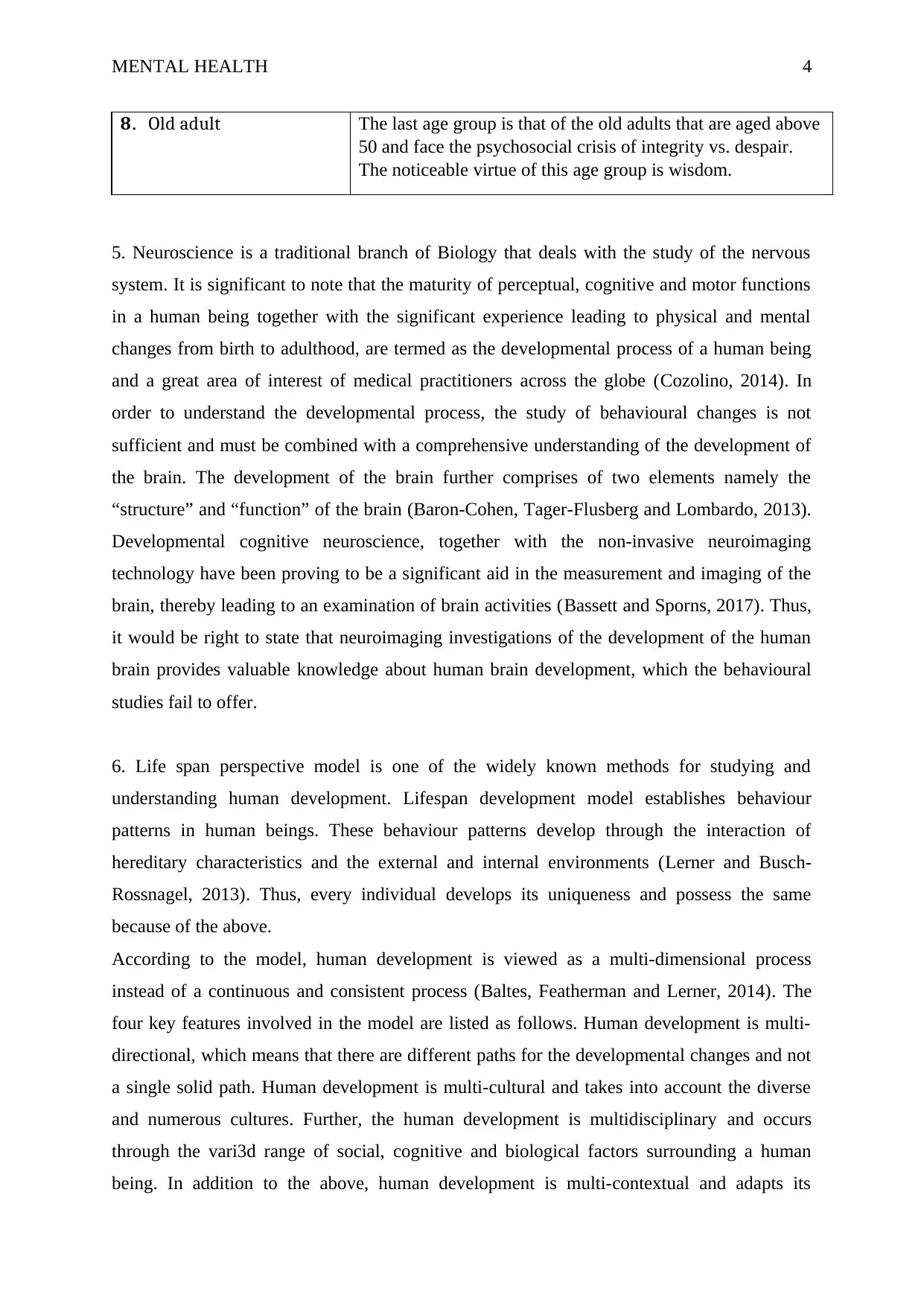
MENTAL HEALTH 4
8. Old adult The last age group is that of the old adults that are aged above
50 and face the psychosocial crisis of integrity vs. despair.
The noticeable virtue of this age group is wisdom.
5. Neuroscience is a traditional branch of Biology that deals with the study of the nervous
system. It is significant to note that the maturity of perceptual, cognitive and motor functions
in a human being together with the significant experience leading to physical and mental
changes from birth to adulthood, are termed as the developmental process of a human being
and a great area of interest of medical practitioners across the globe (Cozolino, 2014). In
order to understand the developmental process, the study of behavioural changes is not
sufficient and must be combined with a comprehensive understanding of the development of
the brain. The development of the brain further comprises of two elements namely the
“structure” and “function” of the brain (Baron-Cohen, Tager-Flusberg and Lombardo, 2013).
Developmental cognitive neuroscience, together with the non-invasive neuroimaging
technology have been proving to be a significant aid in the measurement and imaging of the
brain, thereby leading to an examination of brain activities (Bassett and Sporns, 2017). Thus,
it would be right to state that neuroimaging investigations of the development of the human
brain provides valuable knowledge about human brain development, which the behavioural
studies fail to offer.
6. Life span perspective model is one of the widely known methods for studying and
understanding human development. Lifespan development model establishes behaviour
patterns in human beings. These behaviour patterns develop through the interaction of
hereditary characteristics and the external and internal environments (Lerner and Busch-
Rossnagel, 2013). Thus, every individual develops its uniqueness and possess the same
because of the above.
According to the model, human development is viewed as a multi-dimensional process
instead of a continuous and consistent process (Baltes, Featherman and Lerner, 2014). The
four key features involved in the model are listed as follows. Human development is multi-
directional, which means that there are different paths for the developmental changes and not
a single solid path. Human development is multi-cultural and takes into account the diverse
and numerous cultures. Further, the human development is multidisciplinary and occurs
through the vari3d range of social, cognitive and biological factors surrounding a human
being. In addition to the above, human development is multi-contextual and adapts its
8. Old adult The last age group is that of the old adults that are aged above
50 and face the psychosocial crisis of integrity vs. despair.
The noticeable virtue of this age group is wisdom.
5. Neuroscience is a traditional branch of Biology that deals with the study of the nervous
system. It is significant to note that the maturity of perceptual, cognitive and motor functions
in a human being together with the significant experience leading to physical and mental
changes from birth to adulthood, are termed as the developmental process of a human being
and a great area of interest of medical practitioners across the globe (Cozolino, 2014). In
order to understand the developmental process, the study of behavioural changes is not
sufficient and must be combined with a comprehensive understanding of the development of
the brain. The development of the brain further comprises of two elements namely the
“structure” and “function” of the brain (Baron-Cohen, Tager-Flusberg and Lombardo, 2013).
Developmental cognitive neuroscience, together with the non-invasive neuroimaging
technology have been proving to be a significant aid in the measurement and imaging of the
brain, thereby leading to an examination of brain activities (Bassett and Sporns, 2017). Thus,
it would be right to state that neuroimaging investigations of the development of the human
brain provides valuable knowledge about human brain development, which the behavioural
studies fail to offer.
6. Life span perspective model is one of the widely known methods for studying and
understanding human development. Lifespan development model establishes behaviour
patterns in human beings. These behaviour patterns develop through the interaction of
hereditary characteristics and the external and internal environments (Lerner and Busch-
Rossnagel, 2013). Thus, every individual develops its uniqueness and possess the same
because of the above.
According to the model, human development is viewed as a multi-dimensional process
instead of a continuous and consistent process (Baltes, Featherman and Lerner, 2014). The
four key features involved in the model are listed as follows. Human development is multi-
directional, which means that there are different paths for the developmental changes and not
a single solid path. Human development is multi-cultural and takes into account the diverse
and numerous cultures. Further, the human development is multidisciplinary and occurs
through the vari3d range of social, cognitive and biological factors surrounding a human
being. In addition to the above, human development is multi-contextual and adapts its
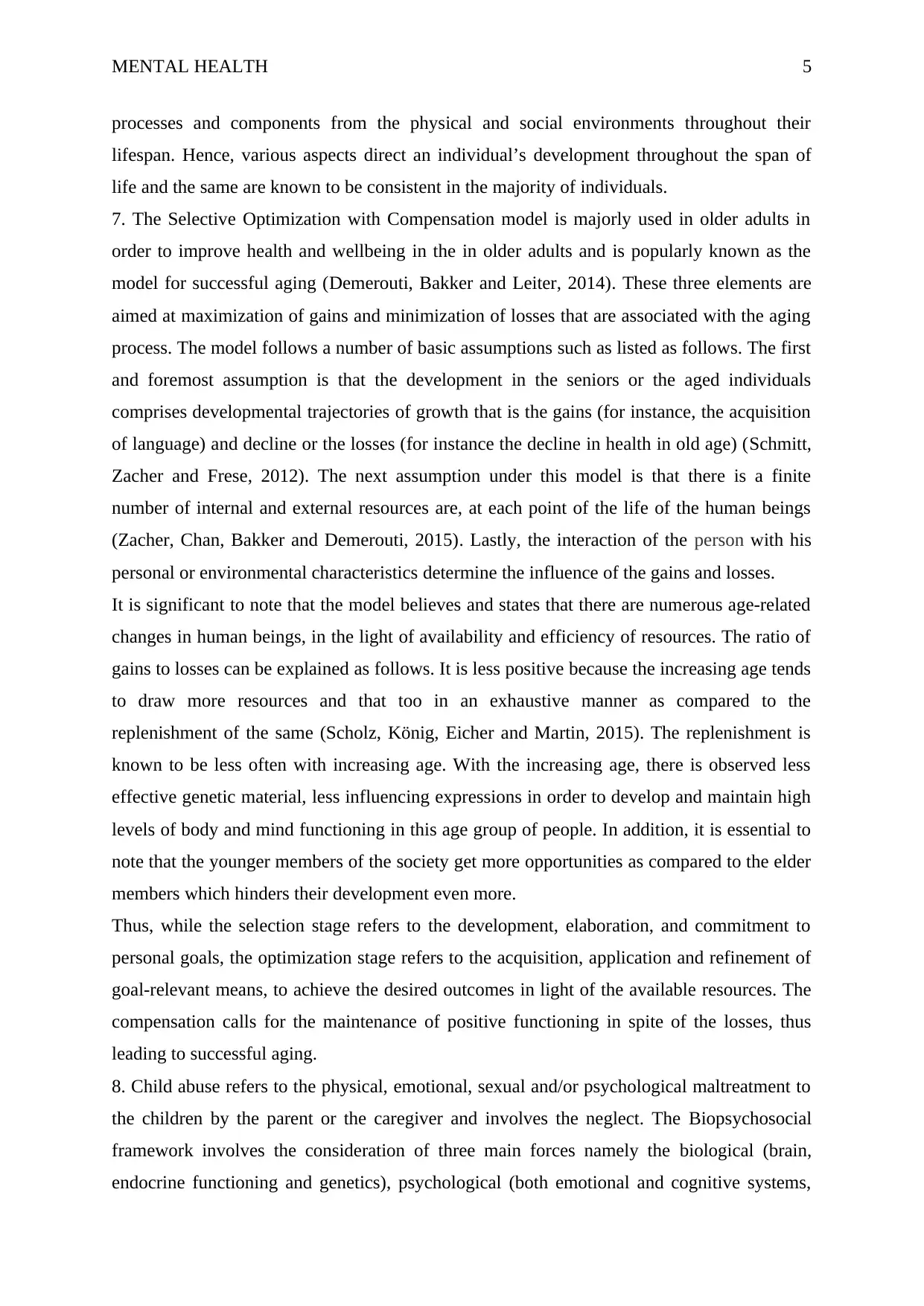
MENTAL HEALTH 5
processes and components from the physical and social environments throughout their
lifespan. Hence, various aspects direct an individual’s development throughout the span of
life and the same are known to be consistent in the majority of individuals.
7. The Selective Optimization with Compensation model is majorly used in older adults in
order to improve health and wellbeing in the in older adults and is popularly known as the
model for successful aging (Demerouti, Bakker and Leiter, 2014). These three elements are
aimed at maximization of gains and minimization of losses that are associated with the aging
process. The model follows a number of basic assumptions such as listed as follows. The first
and foremost assumption is that the development in the seniors or the aged individuals
comprises developmental trajectories of growth that is the gains (for instance, the acquisition
of language) and decline or the losses (for instance the decline in health in old age) (Schmitt,
Zacher and Frese, 2012). The next assumption under this model is that there is a finite
number of internal and external resources are, at each point of the life of the human beings
(Zacher, Chan, Bakker and Demerouti, 2015). Lastly, the interaction of the person with his
personal or environmental characteristics determine the influence of the gains and losses.
It is significant to note that the model believes and states that there are numerous age-related
changes in human beings, in the light of availability and efficiency of resources. The ratio of
gains to losses can be explained as follows. It is less positive because the increasing age tends
to draw more resources and that too in an exhaustive manner as compared to the
replenishment of the same (Scholz, König, Eicher and Martin, 2015). The replenishment is
known to be less often with increasing age. With the increasing age, there is observed less
effective genetic material, less influencing expressions in order to develop and maintain high
levels of body and mind functioning in this age group of people. In addition, it is essential to
note that the younger members of the society get more opportunities as compared to the elder
members which hinders their development even more.
Thus, while the selection stage refers to the development, elaboration, and commitment to
personal goals, the optimization stage refers to the acquisition, application and refinement of
goal-relevant means, to achieve the desired outcomes in light of the available resources. The
compensation calls for the maintenance of positive functioning in spite of the losses, thus
leading to successful aging.
8. Child abuse refers to the physical, emotional, sexual and/or psychological maltreatment to
the children by the parent or the caregiver and involves the neglect. The Biopsychosocial
framework involves the consideration of three main forces namely the biological (brain,
endocrine functioning and genetics), psychological (both emotional and cognitive systems,
processes and components from the physical and social environments throughout their
lifespan. Hence, various aspects direct an individual’s development throughout the span of
life and the same are known to be consistent in the majority of individuals.
7. The Selective Optimization with Compensation model is majorly used in older adults in
order to improve health and wellbeing in the in older adults and is popularly known as the
model for successful aging (Demerouti, Bakker and Leiter, 2014). These three elements are
aimed at maximization of gains and minimization of losses that are associated with the aging
process. The model follows a number of basic assumptions such as listed as follows. The first
and foremost assumption is that the development in the seniors or the aged individuals
comprises developmental trajectories of growth that is the gains (for instance, the acquisition
of language) and decline or the losses (for instance the decline in health in old age) (Schmitt,
Zacher and Frese, 2012). The next assumption under this model is that there is a finite
number of internal and external resources are, at each point of the life of the human beings
(Zacher, Chan, Bakker and Demerouti, 2015). Lastly, the interaction of the person with his
personal or environmental characteristics determine the influence of the gains and losses.
It is significant to note that the model believes and states that there are numerous age-related
changes in human beings, in the light of availability and efficiency of resources. The ratio of
gains to losses can be explained as follows. It is less positive because the increasing age tends
to draw more resources and that too in an exhaustive manner as compared to the
replenishment of the same (Scholz, König, Eicher and Martin, 2015). The replenishment is
known to be less often with increasing age. With the increasing age, there is observed less
effective genetic material, less influencing expressions in order to develop and maintain high
levels of body and mind functioning in this age group of people. In addition, it is essential to
note that the younger members of the society get more opportunities as compared to the elder
members which hinders their development even more.
Thus, while the selection stage refers to the development, elaboration, and commitment to
personal goals, the optimization stage refers to the acquisition, application and refinement of
goal-relevant means, to achieve the desired outcomes in light of the available resources. The
compensation calls for the maintenance of positive functioning in spite of the losses, thus
leading to successful aging.
8. Child abuse refers to the physical, emotional, sexual and/or psychological maltreatment to
the children by the parent or the caregiver and involves the neglect. The Biopsychosocial
framework involves the consideration of three main forces namely the biological (brain,
endocrine functioning and genetics), psychological (both emotional and cognitive systems,
⊘ This is a preview!⊘
Do you want full access?
Subscribe today to unlock all pages.

Trusted by 1+ million students worldwide
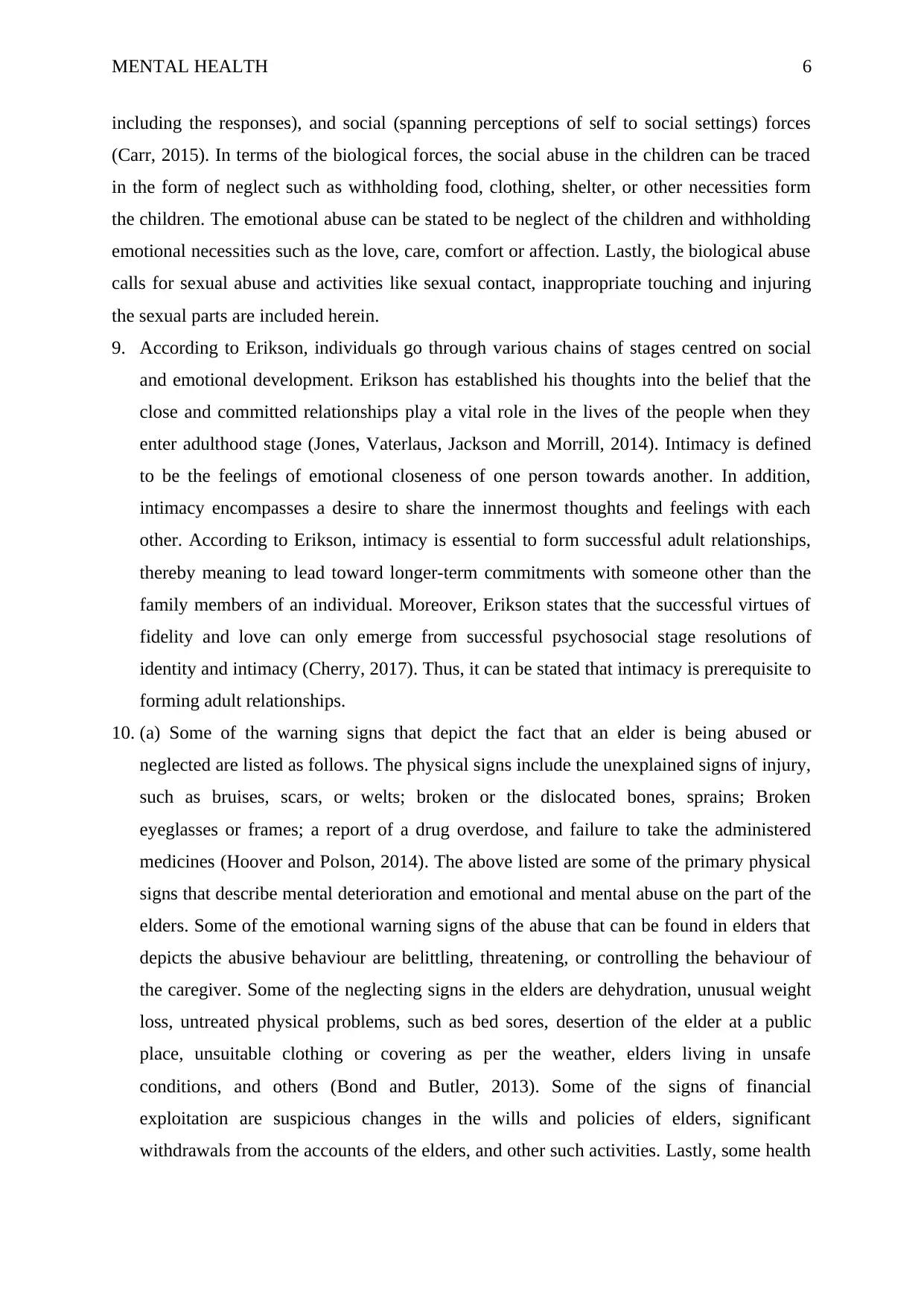
MENTAL HEALTH 6
including the responses), and social (spanning perceptions of self to social settings) forces
(Carr, 2015). In terms of the biological forces, the social abuse in the children can be traced
in the form of neglect such as withholding food, clothing, shelter, or other necessities form
the children. The emotional abuse can be stated to be neglect of the children and withholding
emotional necessities such as the love, care, comfort or affection. Lastly, the biological abuse
calls for sexual abuse and activities like sexual contact, inappropriate touching and injuring
the sexual parts are included herein.
9. According to Erikson, individuals go through various chains of stages centred on social
and emotional development. Erikson has established his thoughts into the belief that the
close and committed relationships play a vital role in the lives of the people when they
enter adulthood stage (Jones, Vaterlaus, Jackson and Morrill, 2014). Intimacy is defined
to be the feelings of emotional closeness of one person towards another. In addition,
intimacy encompasses a desire to share the innermost thoughts and feelings with each
other. According to Erikson, intimacy is essential to form successful adult relationships,
thereby meaning to lead toward longer-term commitments with someone other than the
family members of an individual. Moreover, Erikson states that the successful virtues of
fidelity and love can only emerge from successful psychosocial stage resolutions of
identity and intimacy (Cherry, 2017). Thus, it can be stated that intimacy is prerequisite to
forming adult relationships.
10. (a) Some of the warning signs that depict the fact that an elder is being abused or
neglected are listed as follows. The physical signs include the unexplained signs of injury,
such as bruises, scars, or welts; broken or the dislocated bones, sprains; Broken
eyeglasses or frames; a report of a drug overdose, and failure to take the administered
medicines (Hoover and Polson, 2014). The above listed are some of the primary physical
signs that describe mental deterioration and emotional and mental abuse on the part of the
elders. Some of the emotional warning signs of the abuse that can be found in elders that
depicts the abusive behaviour are belittling, threatening, or controlling the behaviour of
the caregiver. Some of the neglecting signs in the elders are dehydration, unusual weight
loss, untreated physical problems, such as bed sores, desertion of the elder at a public
place, unsuitable clothing or covering as per the weather, elders living in unsafe
conditions, and others (Bond and Butler, 2013). Some of the signs of financial
exploitation are suspicious changes in the wills and policies of elders, significant
withdrawals from the accounts of the elders, and other such activities. Lastly, some health
including the responses), and social (spanning perceptions of self to social settings) forces
(Carr, 2015). In terms of the biological forces, the social abuse in the children can be traced
in the form of neglect such as withholding food, clothing, shelter, or other necessities form
the children. The emotional abuse can be stated to be neglect of the children and withholding
emotional necessities such as the love, care, comfort or affection. Lastly, the biological abuse
calls for sexual abuse and activities like sexual contact, inappropriate touching and injuring
the sexual parts are included herein.
9. According to Erikson, individuals go through various chains of stages centred on social
and emotional development. Erikson has established his thoughts into the belief that the
close and committed relationships play a vital role in the lives of the people when they
enter adulthood stage (Jones, Vaterlaus, Jackson and Morrill, 2014). Intimacy is defined
to be the feelings of emotional closeness of one person towards another. In addition,
intimacy encompasses a desire to share the innermost thoughts and feelings with each
other. According to Erikson, intimacy is essential to form successful adult relationships,
thereby meaning to lead toward longer-term commitments with someone other than the
family members of an individual. Moreover, Erikson states that the successful virtues of
fidelity and love can only emerge from successful psychosocial stage resolutions of
identity and intimacy (Cherry, 2017). Thus, it can be stated that intimacy is prerequisite to
forming adult relationships.
10. (a) Some of the warning signs that depict the fact that an elder is being abused or
neglected are listed as follows. The physical signs include the unexplained signs of injury,
such as bruises, scars, or welts; broken or the dislocated bones, sprains; Broken
eyeglasses or frames; a report of a drug overdose, and failure to take the administered
medicines (Hoover and Polson, 2014). The above listed are some of the primary physical
signs that describe mental deterioration and emotional and mental abuse on the part of the
elders. Some of the emotional warning signs of the abuse that can be found in elders that
depicts the abusive behaviour are belittling, threatening, or controlling the behaviour of
the caregiver. Some of the neglecting signs in the elders are dehydration, unusual weight
loss, untreated physical problems, such as bed sores, desertion of the elder at a public
place, unsuitable clothing or covering as per the weather, elders living in unsafe
conditions, and others (Bond and Butler, 2013). Some of the signs of financial
exploitation are suspicious changes in the wills and policies of elders, significant
withdrawals from the accounts of the elders, and other such activities. Lastly, some health
Paraphrase This Document
Need a fresh take? Get an instant paraphrase of this document with our AI Paraphraser
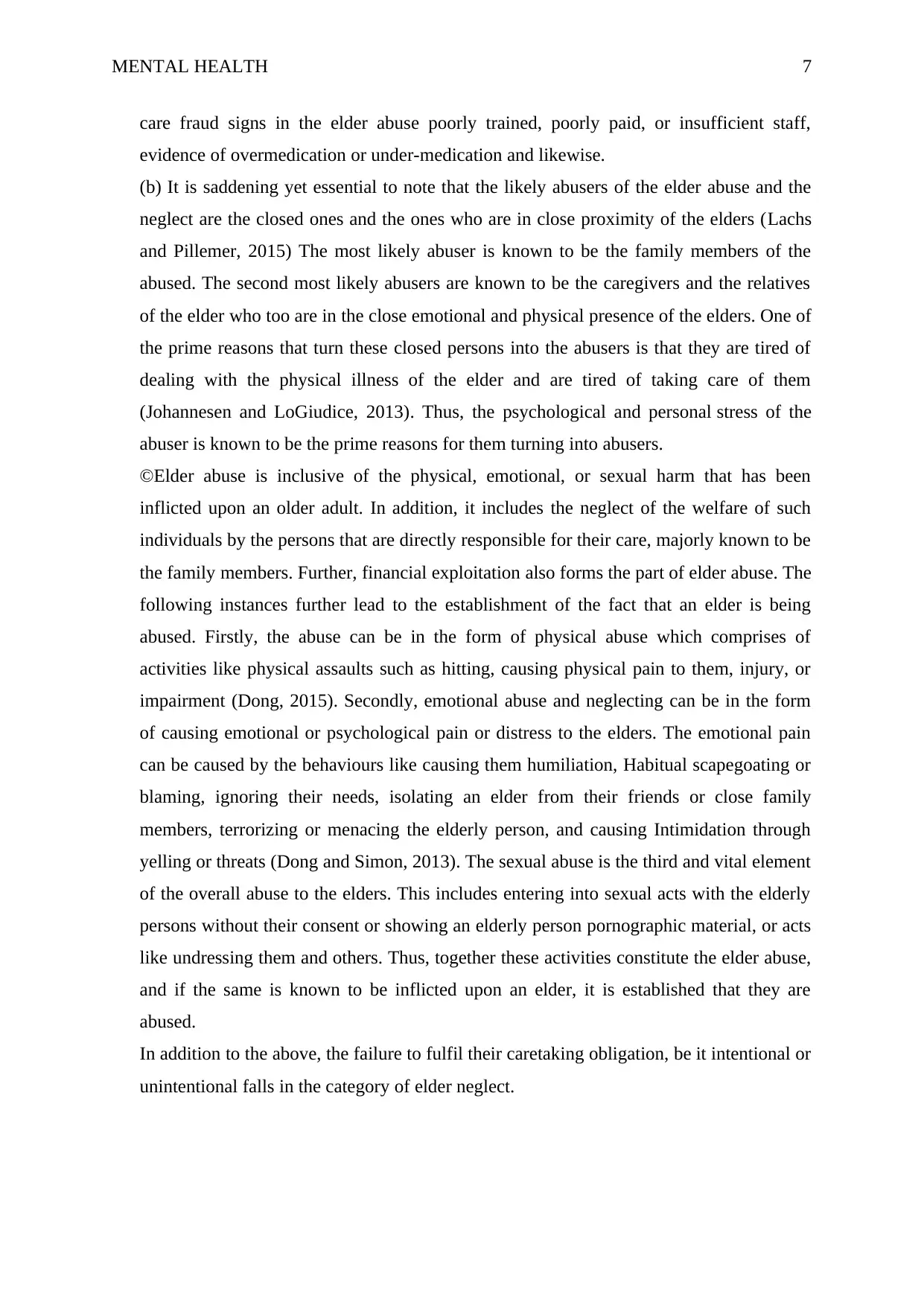
MENTAL HEALTH 7
care fraud signs in the elder abuse poorly trained, poorly paid, or insufficient staff,
evidence of overmedication or under-medication and likewise.
(b) It is saddening yet essential to note that the likely abusers of the elder abuse and the
neglect are the closed ones and the ones who are in close proximity of the elders (Lachs
and Pillemer, 2015) The most likely abuser is known to be the family members of the
abused. The second most likely abusers are known to be the caregivers and the relatives
of the elder who too are in the close emotional and physical presence of the elders. One of
the prime reasons that turn these closed persons into the abusers is that they are tired of
dealing with the physical illness of the elder and are tired of taking care of them
(Johannesen and LoGiudice, 2013). Thus, the psychological and personal stress of the
abuser is known to be the prime reasons for them turning into abusers.
©Elder abuse is inclusive of the physical, emotional, or sexual harm that has been
inflicted upon an older adult. In addition, it includes the neglect of the welfare of such
individuals by the persons that are directly responsible for their care, majorly known to be
the family members. Further, financial exploitation also forms the part of elder abuse. The
following instances further lead to the establishment of the fact that an elder is being
abused. Firstly, the abuse can be in the form of physical abuse which comprises of
activities like physical assaults such as hitting, causing physical pain to them, injury, or
impairment (Dong, 2015). Secondly, emotional abuse and neglecting can be in the form
of causing emotional or psychological pain or distress to the elders. The emotional pain
can be caused by the behaviours like causing them humiliation, Habitual scapegoating or
blaming, ignoring their needs, isolating an elder from their friends or close family
members, terrorizing or menacing the elderly person, and causing Intimidation through
yelling or threats (Dong and Simon, 2013). The sexual abuse is the third and vital element
of the overall abuse to the elders. This includes entering into sexual acts with the elderly
persons without their consent or showing an elderly person pornographic material, or acts
like undressing them and others. Thus, together these activities constitute the elder abuse,
and if the same is known to be inflicted upon an elder, it is established that they are
abused.
In addition to the above, the failure to fulfil their caretaking obligation, be it intentional or
unintentional falls in the category of elder neglect.
care fraud signs in the elder abuse poorly trained, poorly paid, or insufficient staff,
evidence of overmedication or under-medication and likewise.
(b) It is saddening yet essential to note that the likely abusers of the elder abuse and the
neglect are the closed ones and the ones who are in close proximity of the elders (Lachs
and Pillemer, 2015) The most likely abuser is known to be the family members of the
abused. The second most likely abusers are known to be the caregivers and the relatives
of the elder who too are in the close emotional and physical presence of the elders. One of
the prime reasons that turn these closed persons into the abusers is that they are tired of
dealing with the physical illness of the elder and are tired of taking care of them
(Johannesen and LoGiudice, 2013). Thus, the psychological and personal stress of the
abuser is known to be the prime reasons for them turning into abusers.
©Elder abuse is inclusive of the physical, emotional, or sexual harm that has been
inflicted upon an older adult. In addition, it includes the neglect of the welfare of such
individuals by the persons that are directly responsible for their care, majorly known to be
the family members. Further, financial exploitation also forms the part of elder abuse. The
following instances further lead to the establishment of the fact that an elder is being
abused. Firstly, the abuse can be in the form of physical abuse which comprises of
activities like physical assaults such as hitting, causing physical pain to them, injury, or
impairment (Dong, 2015). Secondly, emotional abuse and neglecting can be in the form
of causing emotional or psychological pain or distress to the elders. The emotional pain
can be caused by the behaviours like causing them humiliation, Habitual scapegoating or
blaming, ignoring their needs, isolating an elder from their friends or close family
members, terrorizing or menacing the elderly person, and causing Intimidation through
yelling or threats (Dong and Simon, 2013). The sexual abuse is the third and vital element
of the overall abuse to the elders. This includes entering into sexual acts with the elderly
persons without their consent or showing an elderly person pornographic material, or acts
like undressing them and others. Thus, together these activities constitute the elder abuse,
and if the same is known to be inflicted upon an elder, it is established that they are
abused.
In addition to the above, the failure to fulfil their caretaking obligation, be it intentional or
unintentional falls in the category of elder neglect.
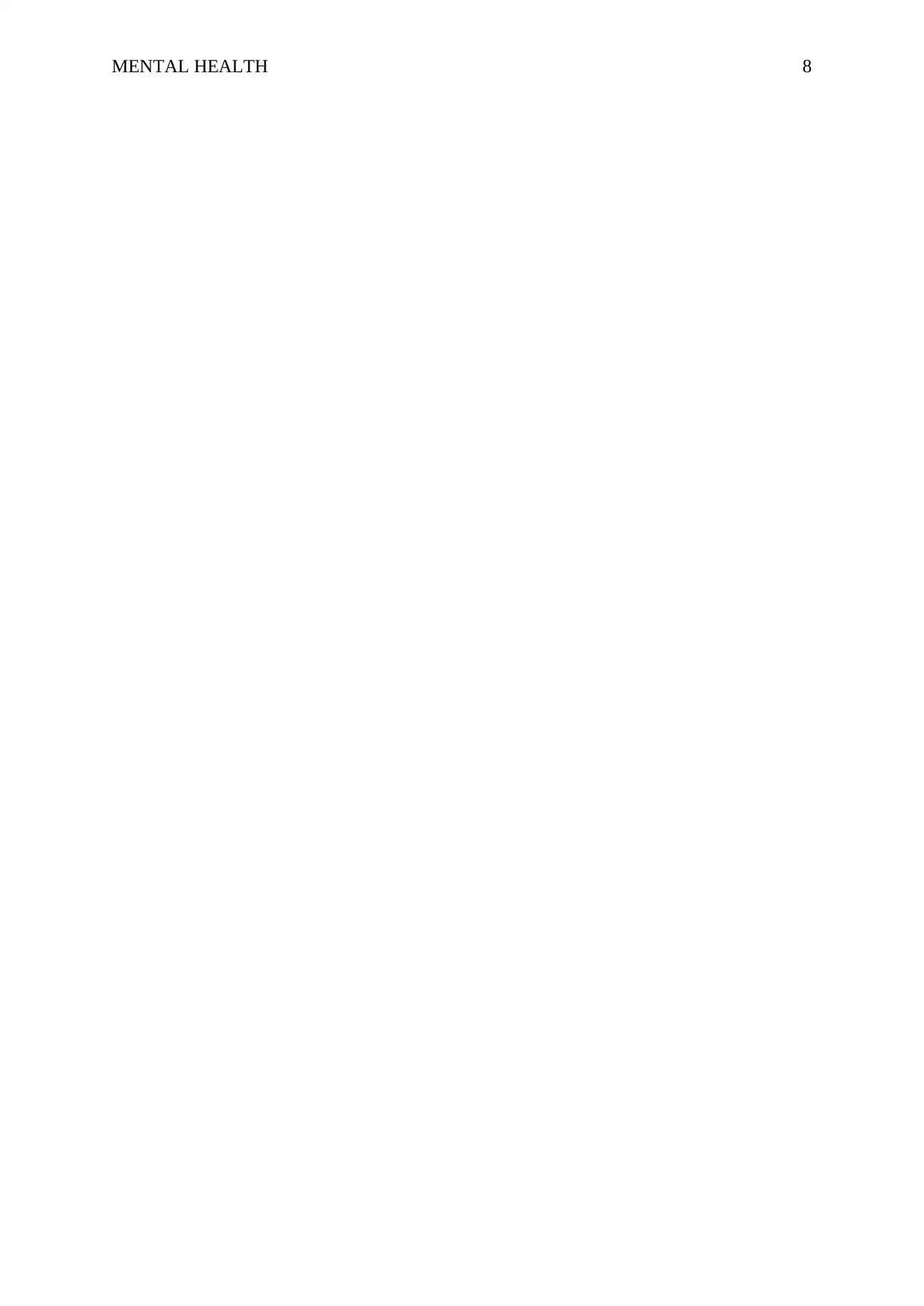
MENTAL HEALTH 8
⊘ This is a preview!⊘
Do you want full access?
Subscribe today to unlock all pages.

Trusted by 1+ million students worldwide
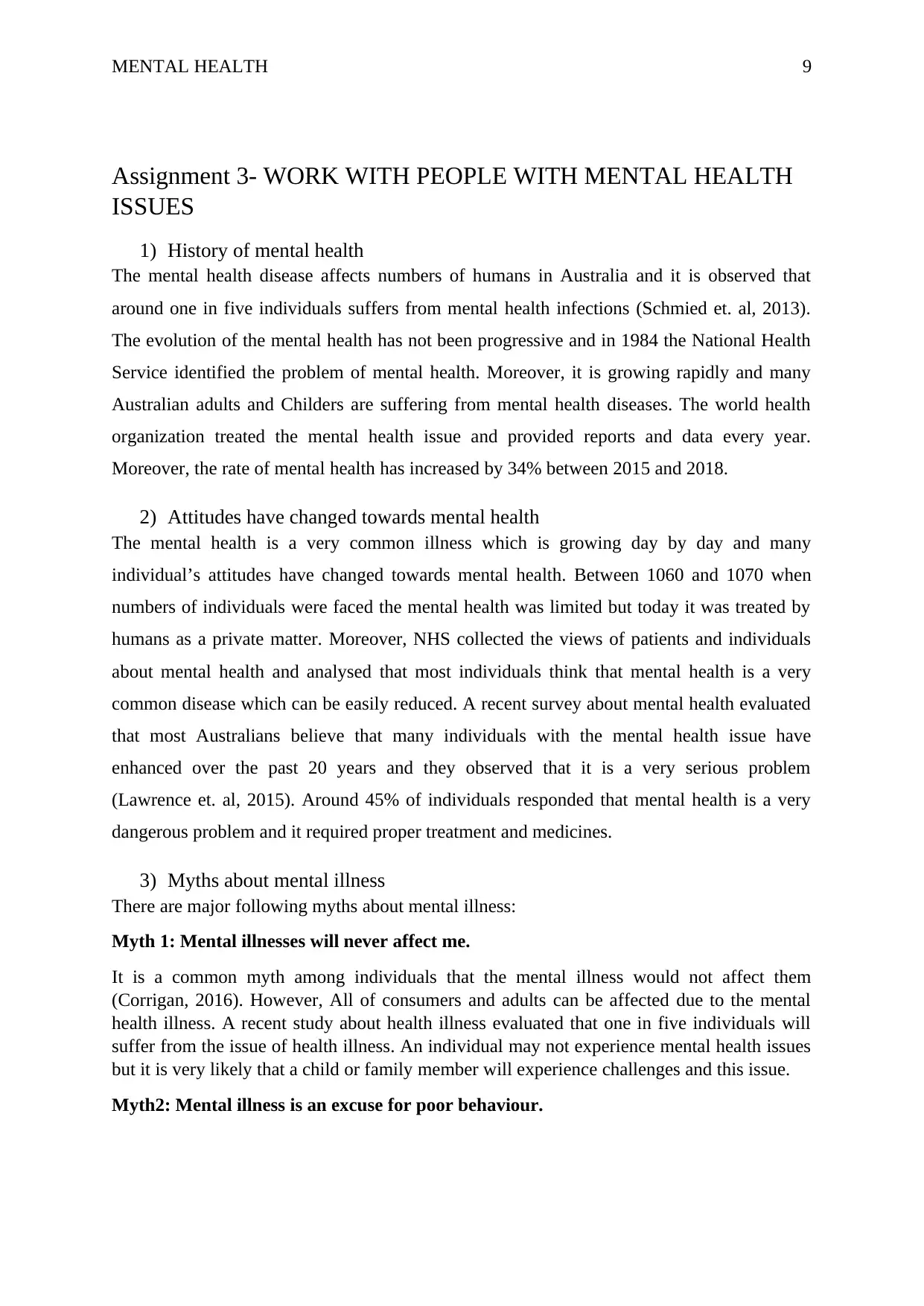
MENTAL HEALTH 9
Assignment 3- WORK WITH PEOPLE WITH MENTAL HEALTH
ISSUES
1) History of mental health
The mental health disease affects numbers of humans in Australia and it is observed that
around one in five individuals suffers from mental health infections (Schmied et. al, 2013).
The evolution of the mental health has not been progressive and in 1984 the National Health
Service identified the problem of mental health. Moreover, it is growing rapidly and many
Australian adults and Childers are suffering from mental health diseases. The world health
organization treated the mental health issue and provided reports and data every year.
Moreover, the rate of mental health has increased by 34% between 2015 and 2018.
2) Attitudes have changed towards mental health
The mental health is a very common illness which is growing day by day and many
individual’s attitudes have changed towards mental health. Between 1060 and 1070 when
numbers of individuals were faced the mental health was limited but today it was treated by
humans as a private matter. Moreover, NHS collected the views of patients and individuals
about mental health and analysed that most individuals think that mental health is a very
common disease which can be easily reduced. A recent survey about mental health evaluated
that most Australians believe that many individuals with the mental health issue have
enhanced over the past 20 years and they observed that it is a very serious problem
(Lawrence et. al, 2015). Around 45% of individuals responded that mental health is a very
dangerous problem and it required proper treatment and medicines.
3) Myths about mental illness
There are major following myths about mental illness:
Myth 1: Mental illnesses will never affect me.
It is a common myth among individuals that the mental illness would not affect them
(Corrigan, 2016). However, All of consumers and adults can be affected due to the mental
health illness. A recent study about health illness evaluated that one in five individuals will
suffer from the issue of health illness. An individual may not experience mental health issues
but it is very likely that a child or family member will experience challenges and this issue.
Myth2: Mental illness is an excuse for poor behaviour.
Assignment 3- WORK WITH PEOPLE WITH MENTAL HEALTH
ISSUES
1) History of mental health
The mental health disease affects numbers of humans in Australia and it is observed that
around one in five individuals suffers from mental health infections (Schmied et. al, 2013).
The evolution of the mental health has not been progressive and in 1984 the National Health
Service identified the problem of mental health. Moreover, it is growing rapidly and many
Australian adults and Childers are suffering from mental health diseases. The world health
organization treated the mental health issue and provided reports and data every year.
Moreover, the rate of mental health has increased by 34% between 2015 and 2018.
2) Attitudes have changed towards mental health
The mental health is a very common illness which is growing day by day and many
individual’s attitudes have changed towards mental health. Between 1060 and 1070 when
numbers of individuals were faced the mental health was limited but today it was treated by
humans as a private matter. Moreover, NHS collected the views of patients and individuals
about mental health and analysed that most individuals think that mental health is a very
common disease which can be easily reduced. A recent survey about mental health evaluated
that most Australians believe that many individuals with the mental health issue have
enhanced over the past 20 years and they observed that it is a very serious problem
(Lawrence et. al, 2015). Around 45% of individuals responded that mental health is a very
dangerous problem and it required proper treatment and medicines.
3) Myths about mental illness
There are major following myths about mental illness:
Myth 1: Mental illnesses will never affect me.
It is a common myth among individuals that the mental illness would not affect them
(Corrigan, 2016). However, All of consumers and adults can be affected due to the mental
health illness. A recent study about health illness evaluated that one in five individuals will
suffer from the issue of health illness. An individual may not experience mental health issues
but it is very likely that a child or family member will experience challenges and this issue.
Myth2: Mental illness is an excuse for poor behaviour.
Paraphrase This Document
Need a fresh take? Get an instant paraphrase of this document with our AI Paraphraser
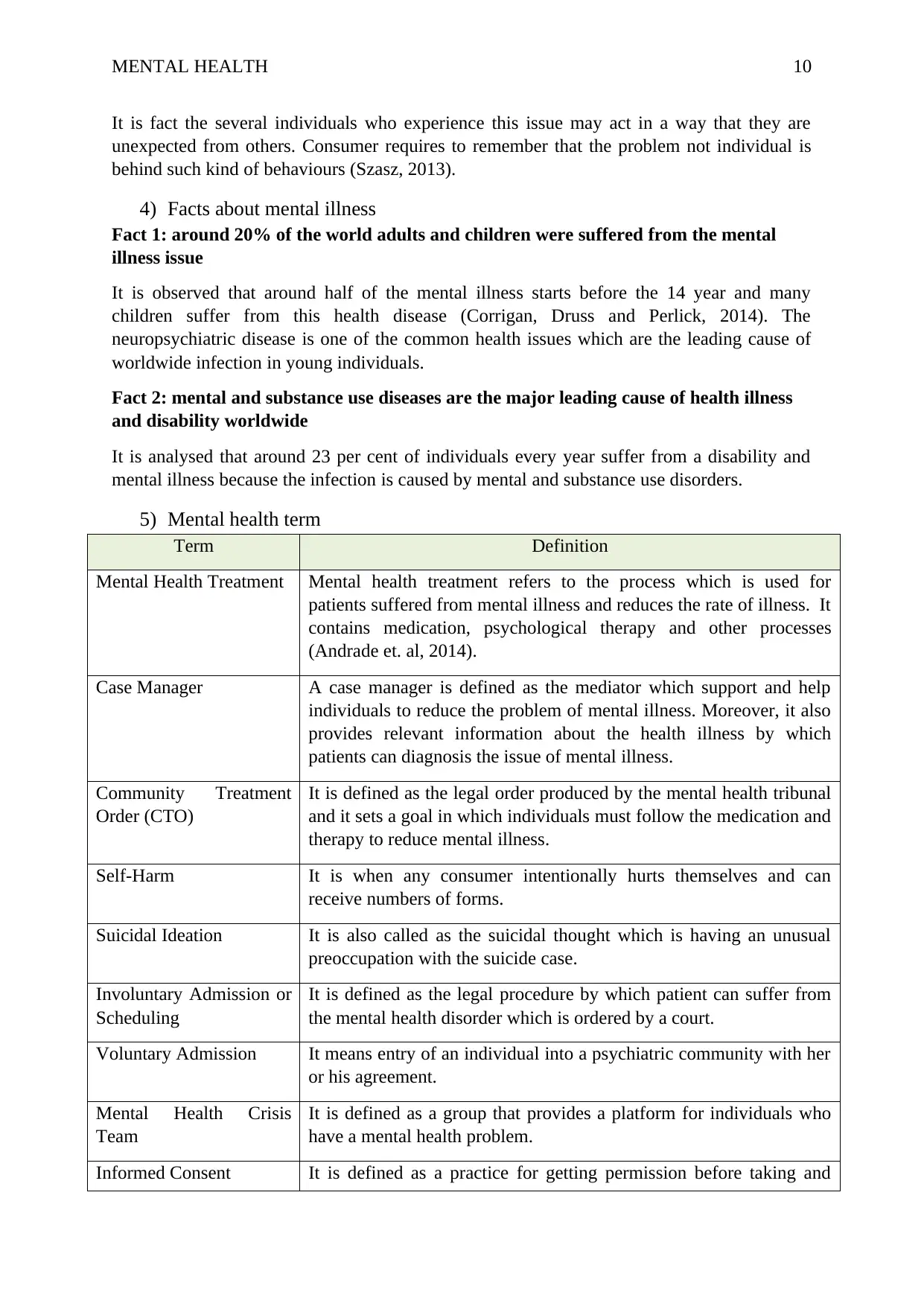
MENTAL HEALTH 10
It is fact the several individuals who experience this issue may act in a way that they are
unexpected from others. Consumer requires to remember that the problem not individual is
behind such kind of behaviours (Szasz, 2013).
4) Facts about mental illness
Fact 1: around 20% of the world adults and children were suffered from the mental
illness issue
It is observed that around half of the mental illness starts before the 14 year and many
children suffer from this health disease (Corrigan, Druss and Perlick, 2014). The
neuropsychiatric disease is one of the common health issues which are the leading cause of
worldwide infection in young individuals.
Fact 2: mental and substance use diseases are the major leading cause of health illness
and disability worldwide
It is analysed that around 23 per cent of individuals every year suffer from a disability and
mental illness because the infection is caused by mental and substance use disorders.
5) Mental health term
Term Definition
Mental Health Treatment Mental health treatment refers to the process which is used for
patients suffered from mental illness and reduces the rate of illness. It
contains medication, psychological therapy and other processes
(Andrade et. al, 2014).
Case Manager A case manager is defined as the mediator which support and help
individuals to reduce the problem of mental illness. Moreover, it also
provides relevant information about the health illness by which
patients can diagnosis the issue of mental illness.
Community Treatment
Order (CTO)
It is defined as the legal order produced by the mental health tribunal
and it sets a goal in which individuals must follow the medication and
therapy to reduce mental illness.
Self-Harm It is when any consumer intentionally hurts themselves and can
receive numbers of forms.
Suicidal Ideation It is also called as the suicidal thought which is having an unusual
preoccupation with the suicide case.
Involuntary Admission or
Scheduling
It is defined as the legal procedure by which patient can suffer from
the mental health disorder which is ordered by a court.
Voluntary Admission It means entry of an individual into a psychiatric community with her
or his agreement.
Mental Health Crisis
Team
It is defined as a group that provides a platform for individuals who
have a mental health problem.
Informed Consent It is defined as a practice for getting permission before taking and
It is fact the several individuals who experience this issue may act in a way that they are
unexpected from others. Consumer requires to remember that the problem not individual is
behind such kind of behaviours (Szasz, 2013).
4) Facts about mental illness
Fact 1: around 20% of the world adults and children were suffered from the mental
illness issue
It is observed that around half of the mental illness starts before the 14 year and many
children suffer from this health disease (Corrigan, Druss and Perlick, 2014). The
neuropsychiatric disease is one of the common health issues which are the leading cause of
worldwide infection in young individuals.
Fact 2: mental and substance use diseases are the major leading cause of health illness
and disability worldwide
It is analysed that around 23 per cent of individuals every year suffer from a disability and
mental illness because the infection is caused by mental and substance use disorders.
5) Mental health term
Term Definition
Mental Health Treatment Mental health treatment refers to the process which is used for
patients suffered from mental illness and reduces the rate of illness. It
contains medication, psychological therapy and other processes
(Andrade et. al, 2014).
Case Manager A case manager is defined as the mediator which support and help
individuals to reduce the problem of mental illness. Moreover, it also
provides relevant information about the health illness by which
patients can diagnosis the issue of mental illness.
Community Treatment
Order (CTO)
It is defined as the legal order produced by the mental health tribunal
and it sets a goal in which individuals must follow the medication and
therapy to reduce mental illness.
Self-Harm It is when any consumer intentionally hurts themselves and can
receive numbers of forms.
Suicidal Ideation It is also called as the suicidal thought which is having an unusual
preoccupation with the suicide case.
Involuntary Admission or
Scheduling
It is defined as the legal procedure by which patient can suffer from
the mental health disorder which is ordered by a court.
Voluntary Admission It means entry of an individual into a psychiatric community with her
or his agreement.
Mental Health Crisis
Team
It is defined as a group that provides a platform for individuals who
have a mental health problem.
Informed Consent It is defined as a practice for getting permission before taking and
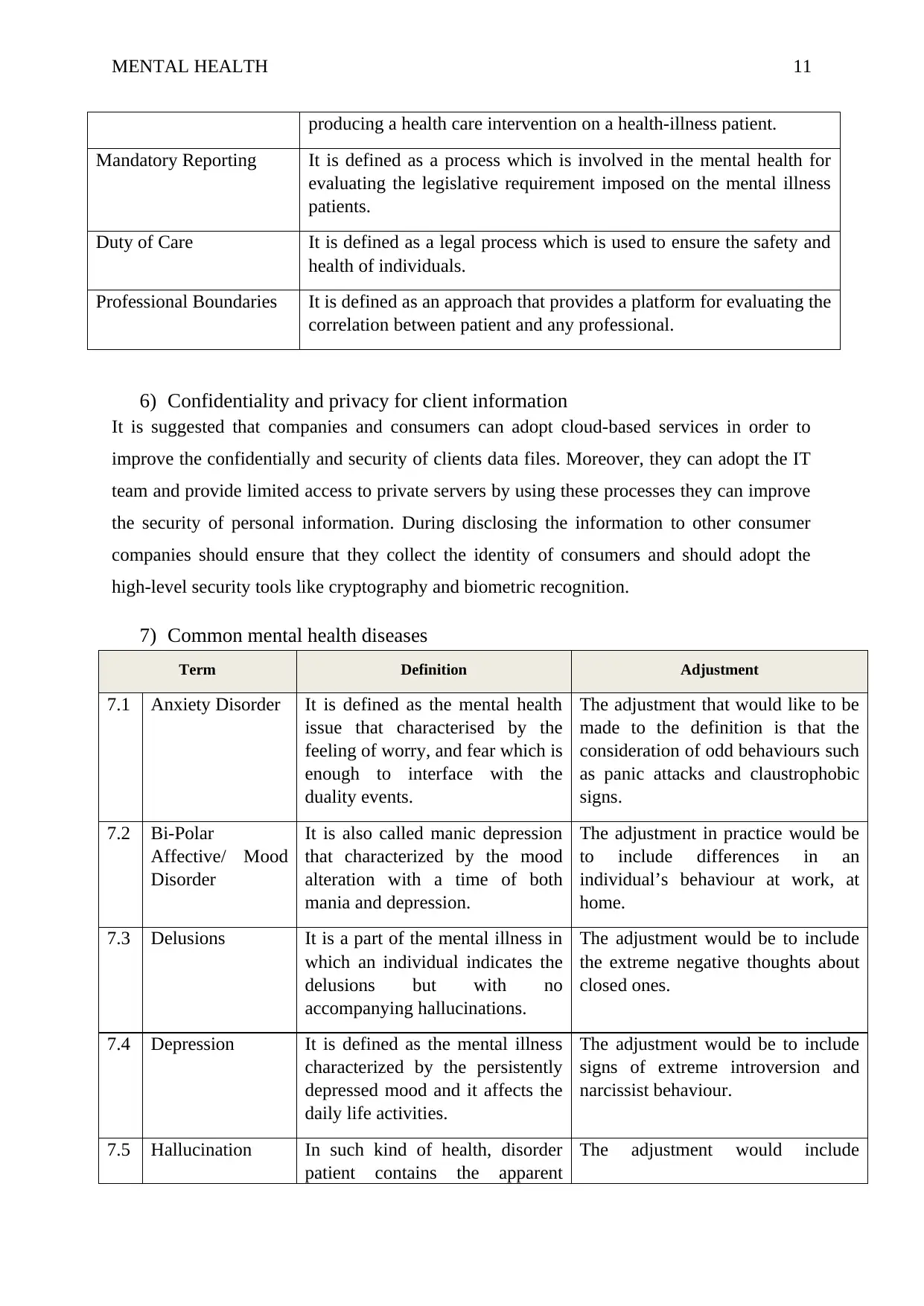
MENTAL HEALTH 11
producing a health care intervention on a health-illness patient.
Mandatory Reporting It is defined as a process which is involved in the mental health for
evaluating the legislative requirement imposed on the mental illness
patients.
Duty of Care It is defined as a legal process which is used to ensure the safety and
health of individuals.
Professional Boundaries It is defined as an approach that provides a platform for evaluating the
correlation between patient and any professional.
6) Confidentiality and privacy for client information
It is suggested that companies and consumers can adopt cloud-based services in order to
improve the confidentially and security of clients data files. Moreover, they can adopt the IT
team and provide limited access to private servers by using these processes they can improve
the security of personal information. During disclosing the information to other consumer
companies should ensure that they collect the identity of consumers and should adopt the
high-level security tools like cryptography and biometric recognition.
7) Common mental health diseases
Term Definition Adjustment
7.1 Anxiety Disorder It is defined as the mental health
issue that characterised by the
feeling of worry, and fear which is
enough to interface with the
duality events.
The adjustment that would like to be
made to the definition is that the
consideration of odd behaviours such
as panic attacks and claustrophobic
signs.
7.2 Bi-Polar
Affective/ Mood
Disorder
It is also called manic depression
that characterized by the mood
alteration with a time of both
mania and depression.
The adjustment in practice would be
to include differences in an
individual’s behaviour at work, at
home.
7.3 Delusions It is a part of the mental illness in
which an individual indicates the
delusions but with no
accompanying hallucinations.
The adjustment would be to include
the extreme negative thoughts about
closed ones.
7.4 Depression It is defined as the mental illness
characterized by the persistently
depressed mood and it affects the
daily life activities.
The adjustment would be to include
signs of extreme introversion and
narcissist behaviour.
7.5 Hallucination In such kind of health, disorder
patient contains the apparent
The adjustment would include
producing a health care intervention on a health-illness patient.
Mandatory Reporting It is defined as a process which is involved in the mental health for
evaluating the legislative requirement imposed on the mental illness
patients.
Duty of Care It is defined as a legal process which is used to ensure the safety and
health of individuals.
Professional Boundaries It is defined as an approach that provides a platform for evaluating the
correlation between patient and any professional.
6) Confidentiality and privacy for client information
It is suggested that companies and consumers can adopt cloud-based services in order to
improve the confidentially and security of clients data files. Moreover, they can adopt the IT
team and provide limited access to private servers by using these processes they can improve
the security of personal information. During disclosing the information to other consumer
companies should ensure that they collect the identity of consumers and should adopt the
high-level security tools like cryptography and biometric recognition.
7) Common mental health diseases
Term Definition Adjustment
7.1 Anxiety Disorder It is defined as the mental health
issue that characterised by the
feeling of worry, and fear which is
enough to interface with the
duality events.
The adjustment that would like to be
made to the definition is that the
consideration of odd behaviours such
as panic attacks and claustrophobic
signs.
7.2 Bi-Polar
Affective/ Mood
Disorder
It is also called manic depression
that characterized by the mood
alteration with a time of both
mania and depression.
The adjustment in practice would be
to include differences in an
individual’s behaviour at work, at
home.
7.3 Delusions It is a part of the mental illness in
which an individual indicates the
delusions but with no
accompanying hallucinations.
The adjustment would be to include
the extreme negative thoughts about
closed ones.
7.4 Depression It is defined as the mental illness
characterized by the persistently
depressed mood and it affects the
daily life activities.
The adjustment would be to include
signs of extreme introversion and
narcissist behaviour.
7.5 Hallucination In such kind of health, disorder
patient contains the apparent
The adjustment would include
⊘ This is a preview!⊘
Do you want full access?
Subscribe today to unlock all pages.

Trusted by 1+ million students worldwide
1 out of 23
Related Documents
Your All-in-One AI-Powered Toolkit for Academic Success.
+13062052269
info@desklib.com
Available 24*7 on WhatsApp / Email
![[object Object]](/_next/static/media/star-bottom.7253800d.svg)
Unlock your academic potential
Copyright © 2020–2025 A2Z Services. All Rights Reserved. Developed and managed by ZUCOL.




